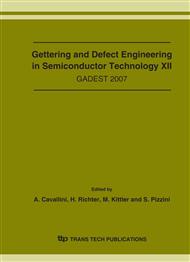p.529
p.535
p.541
p.547
p.553
p.559
p.563
p.571
p.579
Phonon Confinement and Impurity Doping in Silicon Nanowires Synthesized by Laser Ablation
Abstract:
The effect of phonon confinement and impurity doping in silicon nanowires (SiNWs) synthesized by laser ablation were investigated. The diameter of SiNWs was controlled by the synthesis parameters during laser ablation and the subsequent thermal oxidation. Thermal oxidation increases the thickness of the SiNWs’ surface oxide layer, resulting in a decrease in their crystalline Si core diameter. This effect causes a downshift and asymmetric broadening of the Si optical phonon peak due to phonon confinement. Boron doping was also performed during the growth of SiNWs. Local vibrational modes of boron (B) in silicon nanowires (SiNWs) synthesized by laser ablation were observed at about 618 and 640 cm–1 by Raman scattering measurements. Fano broadening due to coupling between discrete optical phonons and the continuum of interband hole excitations was also observed in the Si optical phonon peak. These results prove that B atoms were doped in the SiNWs.
Info:
Periodical:
Pages:
553-558
Citation:
Online since:
October 2007
Authors:
Keywords:
Price:
Сopyright:
© 2008 Trans Tech Publications Ltd. All Rights Reserved
Share:
Citation:


